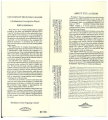Prior Knowledge Of Major Ozone Depletion
In 1975 Semjase gave to Billy prior knowledge that the ozone layer was already being significantly depleted to dangerous levels, and that holes within the ozone layer would develop within a few decades unless the destructive factors were stopped. The destructive factors included the release of bromine gases into the atmosphere by our industry. If holes did develop then all life entering the unshielded areas would be hit by a fatal dose of ultraviolet radiation and suffer a slow and tortuous death. Semjase requested that Billy send a letter to Michael McElroy of Harvard University, USA containing this important knowledge.
The above information was published in 1978 by the late Wendelle Stevens in the English language book UFO Contact from the Pleiades - A Preliminary Investigation Report (ISBN 0-9608558-2-3). The relevant pages from this book are provided below.
The first decreases in Antarctic total ozone were observed in the early 1980s over research stations located on the Antarctic continent. The observations showed unusually low total overhead ozone during the late winter/early spring months of September, October, and November. Total ozone was lower in these months compared with previous observations made as early as 1957. The early published reports came from the British Antarctic Survey and the Japan Meteorological Agency. The results became more widely known in the international community after three scientists from the British Antarctic Survey published them in the journal Nature in 1985 (volume 315). Soon after, satellite measurements confirmed the spring ozone depletion and further showed that in each late winter/early spring season starting in the early 1980s, the depletion extended over a large region centered near the South Pole. The term “ozone hole” came about from satellite images of total ozone that showed very low values encircling the Antarctic continent each spring.[1][2].
The last edition of Wendelle's book was printed in 1982. That is 3 years before the Nature journal (volume 315) was published, making the ozone hole issue widely known in the international community. This proves that Billy had access to advanced and undiscovered scientific knowledge (in 1975 or at the latest, 1982 if this information was only inserted into the last edition of the book).
What happened to the letter that Billy sent to Michael McElroy of Harvard University (in 1975)? Billy never received a reply according to the book but in 1986, Michael McElroy and colleagues described a role for bromine in ozone-depleting reactions.[3][4][5]
Billy
James Moore
References
- ↑ File:WMO-Scientific-Assessment-of-Ozone-Depletion-2006-20-Questions.pdf - See page 21
- ↑ File:Nature-magazine-volume-315-pages-207-210.pdf
- ↑ http://ozonewatch.gsfc.nasa.gov/facts/history.html
- ↑ http://www.nature.com/nature/journal/v321/n6072/pdf/321759a0.pdf
- ↑ http://acmg.seas.harvard.edu/people/faculty/mbm/1980_1989.html




